Abstract
OBJECTIVES: This study examines whether living arrangements and changes in living arrangements are associated with survival among older community-dwelling adults, and whether differences in health status account for observed differences in survival. METHODS: The sample consisted of 5085 persons aged 70 years or older who had participated in the Longitudinal Study of Aging in 1984 and 1986. Proportional hazards models were used to examine associations of survival time through 1990 with living arrangements in 1984 and with changes in living arrangements from 1984 to 1986. RESULTS: Women who lived with someone other than a spouse at baseline or who changed from living with a spouse to living with someone other than a spouse were at greater risk of dying than women in other living arrangements, independent of health status or functioning. Among men, survival time was not generally associated with baseline living arrangements. CONCLUSIONS: Older adults who live alone or who change from living with someone to living alone do not have an increased mortality risk. However, living with or changing to living with someone other than a spouse may be associated with increased mortality risk.
Full text
PDF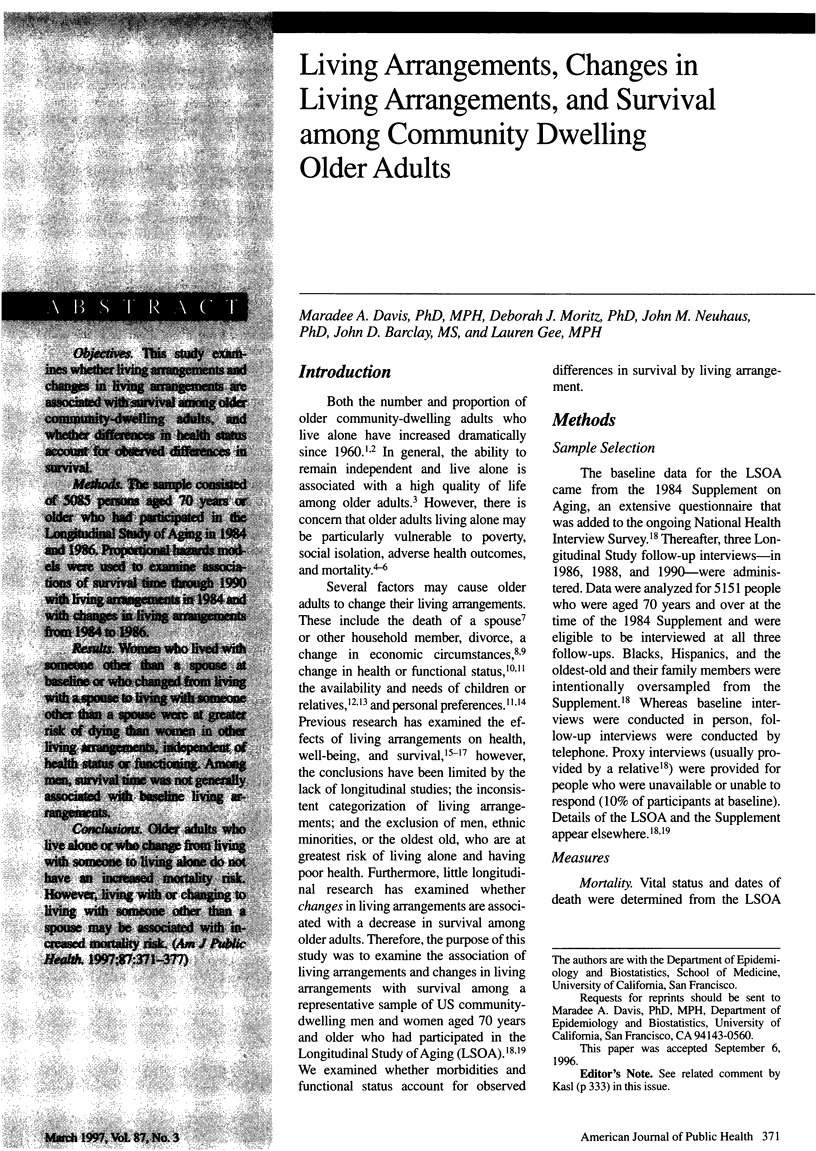
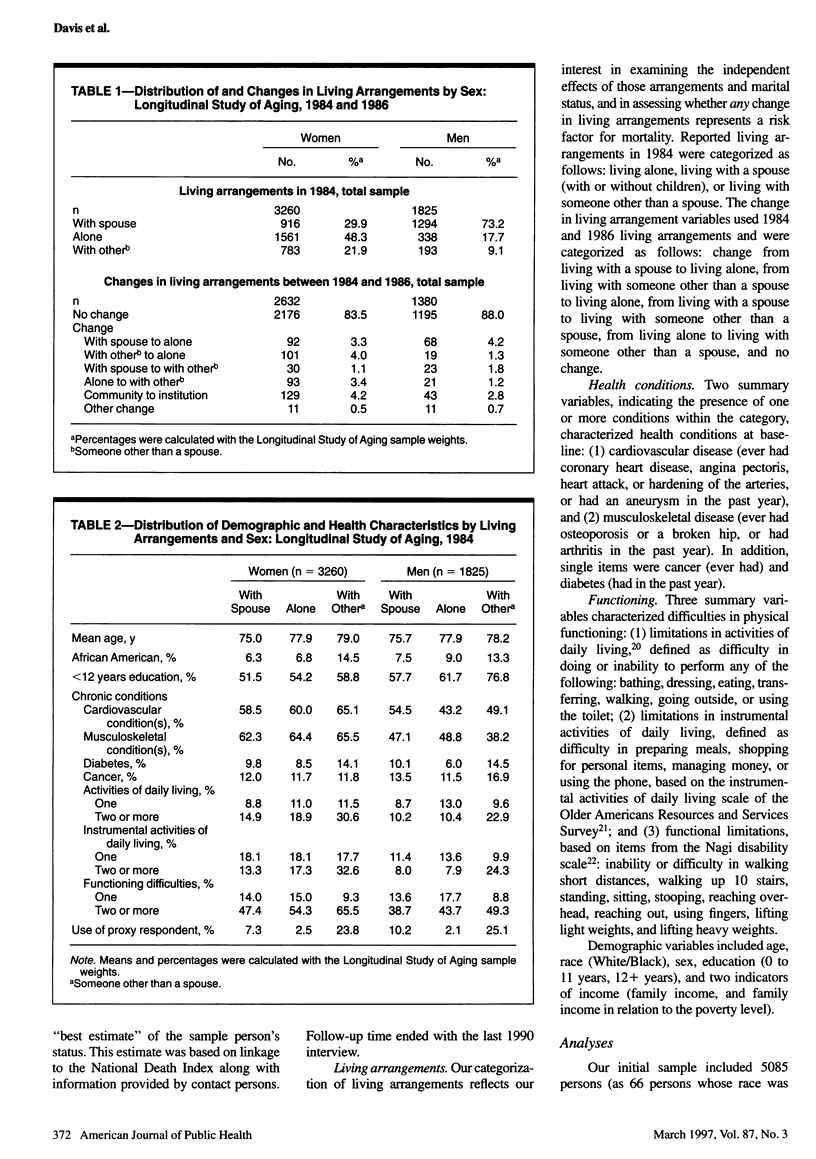
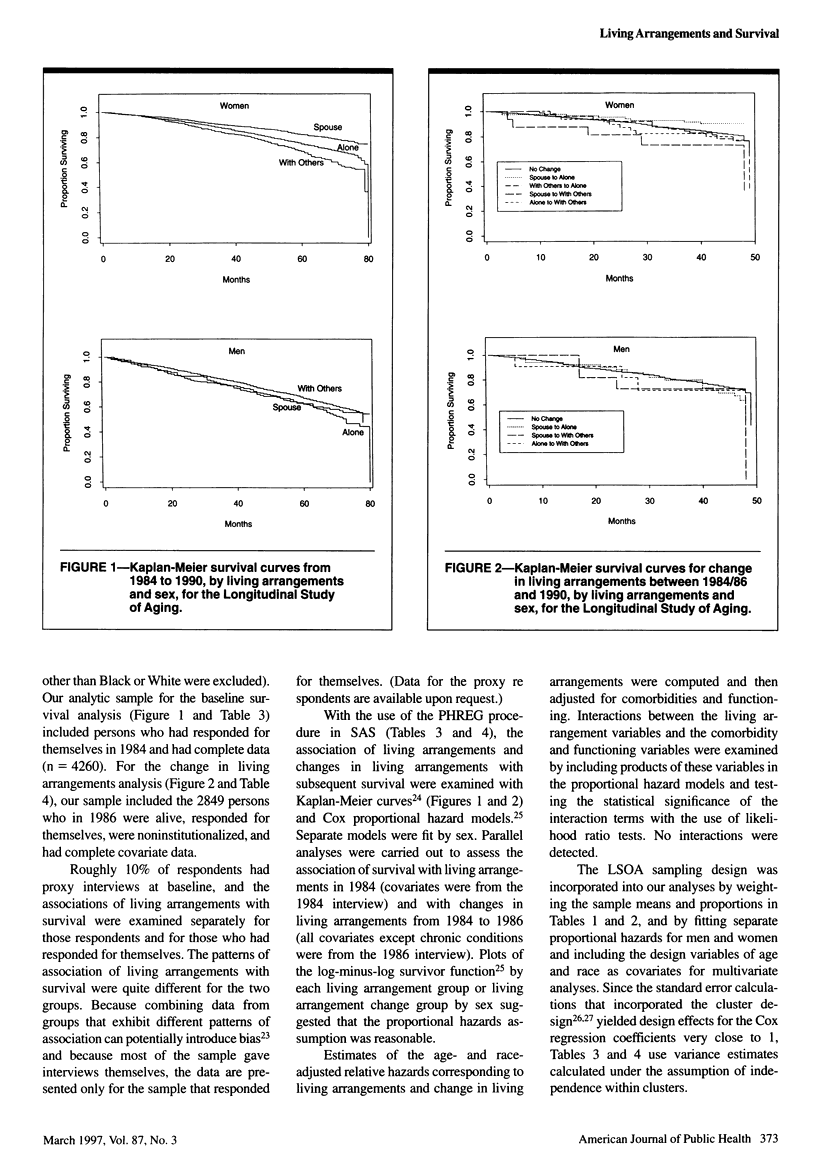
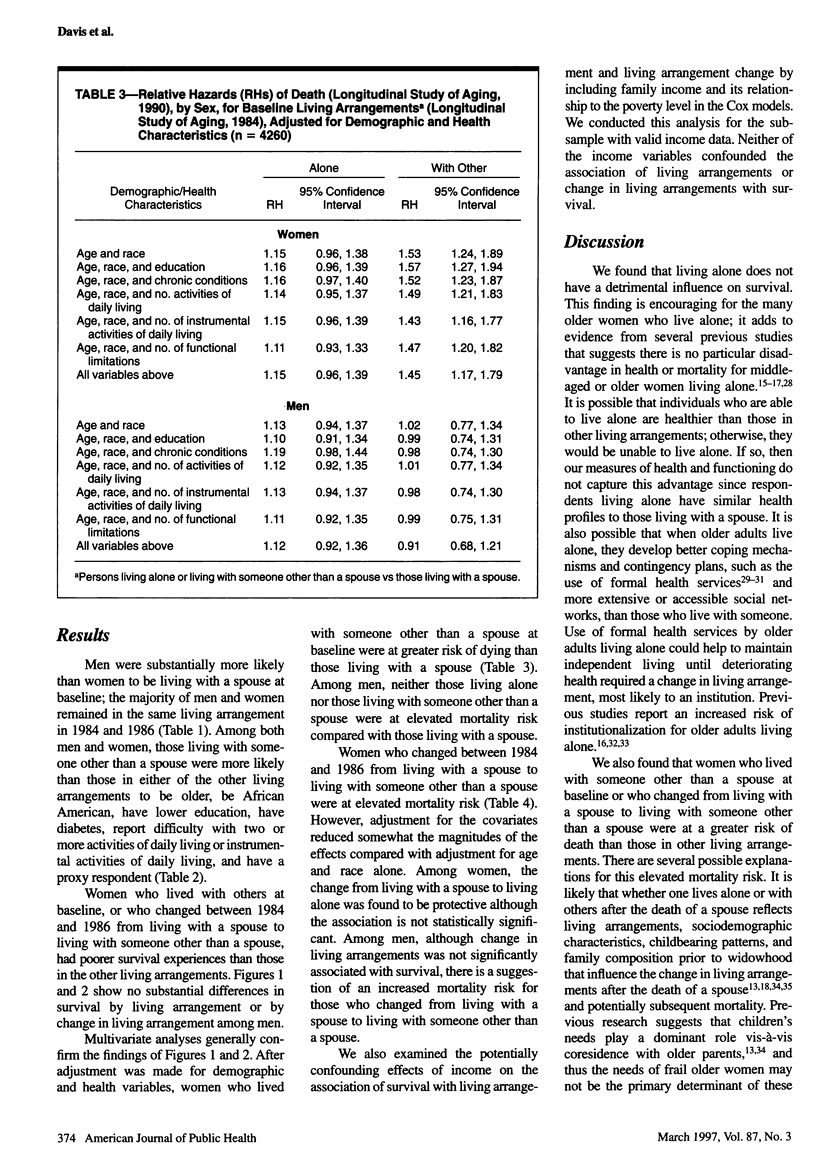
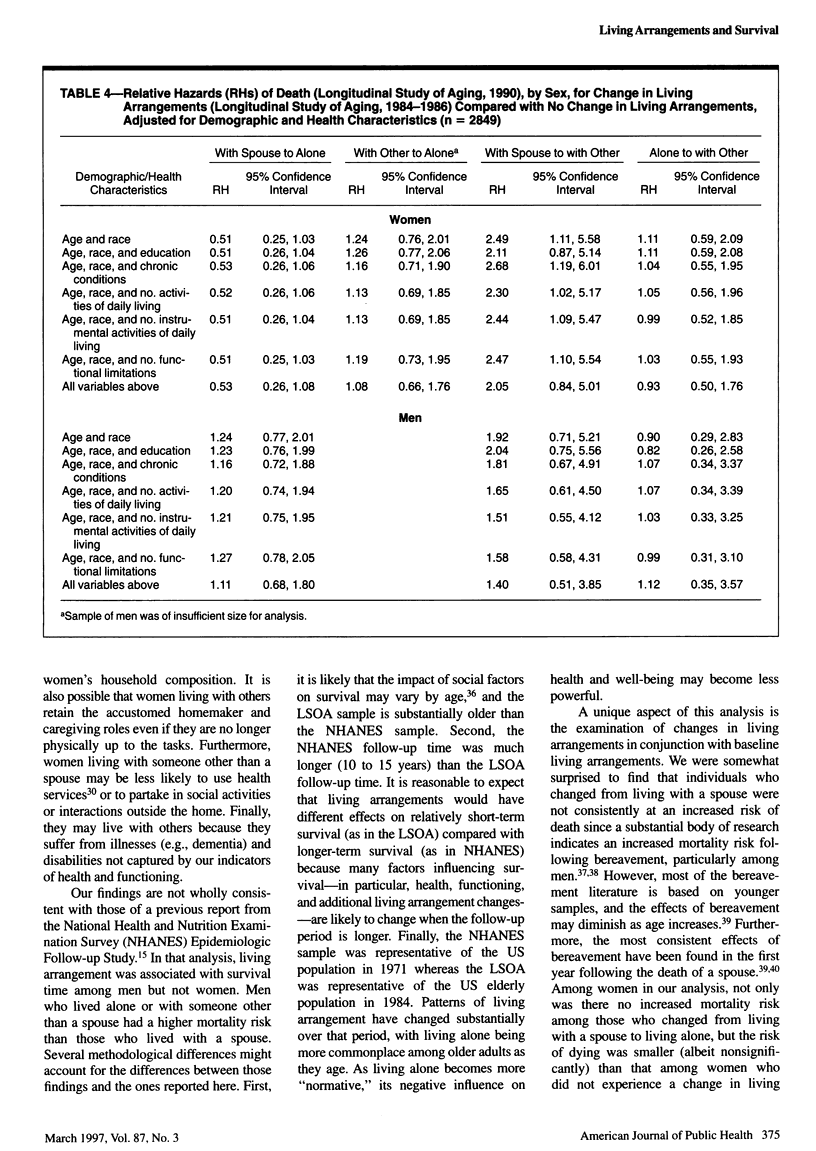


Selected References
These references are in PubMed. This may not be the complete list of references from this article.
- Cafferata G. L. Marital status, living arrangements, and the use of health services by elderly persons. J Gerontol. 1987 Nov;42(6):613–618. doi: 10.1093/geronj/42.6.613. [DOI] [PubMed] [Google Scholar]
- Crimmins E. M., Ingegneri D. G. Interaction and living arrangements of older parents and their children. Past trends, present determinants, future implications. Res Aging. 1990 Mar;12(1):3–35. doi: 10.1177/0164027590121001. [DOI] [PubMed] [Google Scholar]
- Davis M. A., Neuhaus J. M., Moritz D. J., Segal M. R. Living arrangements and survival among middle-aged and older adults in the NHANES I epidemiologic follow-up study. Am J Public Health. 1992 Mar;82(3):401–406. doi: 10.2105/ajph.82.3.401. [DOI] [PMC free article] [PubMed] [Google Scholar]
- Homan S. M., Haddock C. C., Winner C. A., Coe R. M., Wolinsky F. D. Widowhood, sex, labor force participation, and the use of physician services by elderly adults. J Gerontol. 1986 Nov;41(6):793–796. doi: 10.1093/geronj/41.6.793. [DOI] [PubMed] [Google Scholar]
- Jagger C., Sutton C. J. Death after marital bereavement--is the risk increased? Stat Med. 1991 Mar;10(3):395–404. doi: 10.1002/sim.4780100311. [DOI] [PubMed] [Google Scholar]
- KATZ S., FORD A. B., MOSKOWITZ R. W., JACKSON B. A., JAFFE M. W. STUDIES OF ILLNESS IN THE AGED. THE INDEX OF ADL: A STANDARDIZED MEASURE OF BIOLOGICAL AND PSYCHOSOCIAL FUNCTION. JAMA. 1963 Sep 21;185:914–919. doi: 10.1001/jama.1963.03060120024016. [DOI] [PubMed] [Google Scholar]
- Lin D. Y. Cox regression analysis of multivariate failure time data: the marginal approach. Stat Med. 1994 Nov 15;13(21):2233–2247. doi: 10.1002/sim.4780132105. [DOI] [PubMed] [Google Scholar]
- Lin D. Y. MULCOX2: a general computer program for the Cox regression analysis of multivariate failure time data. Comput Methods Programs Biomed. 1993 Aug;40(4):279–293. doi: 10.1016/0169-2607(93)90013-b. [DOI] [PubMed] [Google Scholar]
- Magaziner J., Cadigan D. A., Hebel J. R., Parry R. E. Health and living arrangements among older women: does living alone increase the risk of illness? J Gerontol. 1988 Sep;43(5):M127–M133. doi: 10.1093/geronj/43.5.m127. [DOI] [PubMed] [Google Scholar]
- Michael R. T., Fuchs V. R., Scott S. R. Changes in the propensity to live alone: 1950-1976. Demography. 1980 Feb;17(1):39–56. [PubMed] [Google Scholar]
- Mui A. C. Perceived health and functional status among spouse caregivers of frail older persons. J Aging Health. 1995 May;7(2):283–300. doi: 10.1177/089826439500700206. [DOI] [PubMed] [Google Scholar]
- Nagi S. Z. An epidemiology of disability among adults in the United States. Milbank Mem Fund Q Health Soc. 1976 Fall;54(4):439–467. [PubMed] [Google Scholar]
- Schaefer C., Quesenberry C. P., Jr, Wi S. Mortality following conjugal bereavement and the effects of a shared environment. Am J Epidemiol. 1995 Jun 15;141(12):1142–1152. doi: 10.1093/oxfordjournals.aje.a117387. [DOI] [PubMed] [Google Scholar]
- Seeman T. E., Kaplan G. A., Knudsen L., Cohen R., Guralnik J. Social network ties and mortality among the elderly in the Alameda County Study. Am J Epidemiol. 1987 Oct;126(4):714–723. doi: 10.1093/oxfordjournals.aje.a114711. [DOI] [PubMed] [Google Scholar]
- Speare A., Jr, Avery R., Lawton L. Disability, residential mobility, and changes in living arrangements. J Gerontol. 1991 May;46(3):S133–S142. doi: 10.1093/geronj/46.3.s133. [DOI] [PubMed] [Google Scholar]
- Spitze G., Logan J. R., Robinson J. Family structure and changes in living arrangements among elderly nonmarried parents. J Gerontol. 1992 Nov;47(6):S289–S296. doi: 10.1093/geronj/47.6.s289. [DOI] [PubMed] [Google Scholar]
- Stroebe M. S., Stroebe W. Who suffers more? Sex differences in health risks of the widowed. Psychol Bull. 1983 Mar;93(2):279–301. [PubMed] [Google Scholar]
- Tennstedt S. L., Sullivan L. M., McKinlay J. B., D'Agostino R. B. How important is functional status as a predictor of service use by older people? J Aging Health. 1990 Nov;2(4):439–461. doi: 10.1177/089826439000200402. [DOI] [PubMed] [Google Scholar]
- Wolf D. A. Household patterns of older women. Some international comparisons. Res Aging. 1990 Dec;12(4):463–486. doi: 10.1177/0164027590124005. [DOI] [PubMed] [Google Scholar]
- Wolinsky F. D., Callahan C. M., Fitzgerald J. F., Johnson R. J. Changes in functional status and the risks of subsequent nursing home placement and death. J Gerontol. 1993 May;48(3):S94–101. [PubMed] [Google Scholar]
- Wolinsky F. D., Johnson R. L., Stump T. E. The risk of mortality among older adults over an eight-year period. Gerontologist. 1995 Apr;35(2):150–161. doi: 10.1093/geront/35.2.150. [DOI] [PubMed] [Google Scholar]
- Worobey J. L., Angel R. J. Functional capacity and living arrangements of unmarried elderly persons. J Gerontol. 1990 May;45(3):S95–101. doi: 10.1093/geronj/45.3.s95. [DOI] [PubMed] [Google Scholar]


